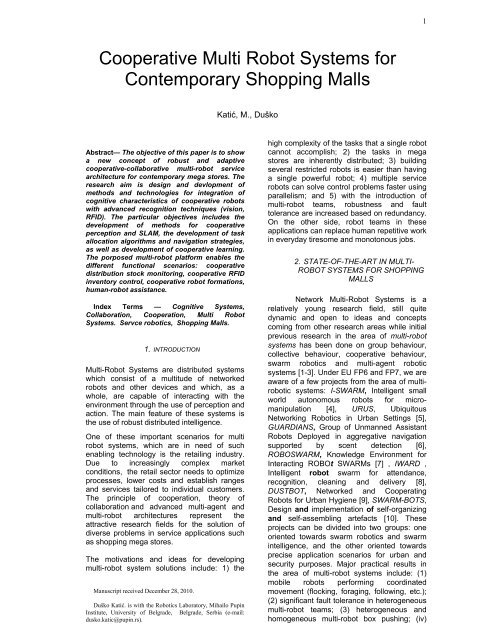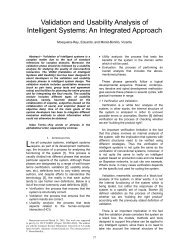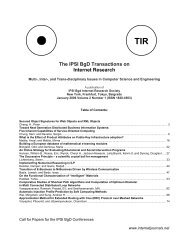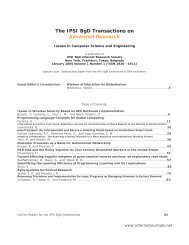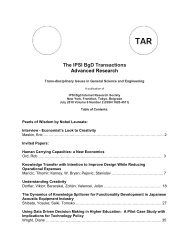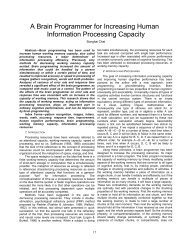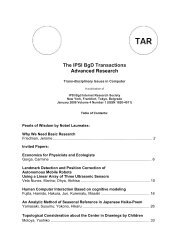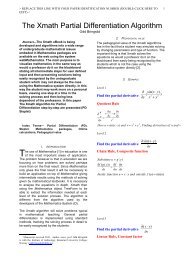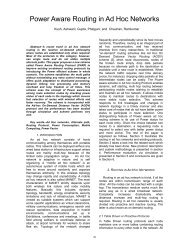Cooperative Multi Robot Systems for Contemporary Shopping Malls
Cooperative Multi Robot Systems for Contemporary Shopping Malls
Cooperative Multi Robot Systems for Contemporary Shopping Malls
You also want an ePaper? Increase the reach of your titles
YUMPU automatically turns print PDFs into web optimized ePapers that Google loves.
1<br />
<strong>Cooperative</strong> <strong>Multi</strong> <strong>Robot</strong> <strong>Systems</strong> <strong>for</strong><br />
<strong>Contemporary</strong> <strong>Shopping</strong> <strong>Malls</strong><br />
Katić, M., Duško<br />
Abstract— The objective of this paper is to show<br />
a new concept of robust and adaptive<br />
cooperative-collaborative multi-robot service<br />
architecture <strong>for</strong> contemporary mega stores. The<br />
research aim is design and devlopment of<br />
methods and technologies <strong>for</strong> integration of<br />
cognitive characteristics of cooperative robots<br />
with advanced recognition techniques (vision,<br />
RFID). The particular objectives includes the<br />
development of methods <strong>for</strong> cooperative<br />
perception and SLAM, the development of task<br />
allocation algorithms and navigation strategies,<br />
as well as development of cooperative learning.<br />
The porposed multi-robot plat<strong>for</strong>m enables the<br />
different functional scenarios: cooperative<br />
distribution stock monitoring, cooperative RFID<br />
inventory control, cooperative robot <strong>for</strong>mations,<br />
human-robot assistance.<br />
Index Terms — Cognitive <strong>Systems</strong>,<br />
Collaboration, Cooperation, <strong>Multi</strong> <strong>Robot</strong><br />
<strong>Systems</strong>. Servce robotics, <strong>Shopping</strong> <strong>Malls</strong>.<br />
1. INTRODUCTION<br />
<strong>Multi</strong>-<strong>Robot</strong> <strong>Systems</strong> are distributed systems<br />
which consist of a multitude of networked<br />
robots and other devices and which, as a<br />
whole, are capable of interacting with the<br />
environment through the use of perception and<br />
action. The main feature of these systems is<br />
the use of robust distributed intelligence.<br />
One of these important scenarios <strong>for</strong> multi<br />
robot systems, which are in need of such<br />
enabling technology is the retailing industry.<br />
Due to increasingly complex market<br />
conditions, the retail sector needs to optimize<br />
processes, lower costs and establish ranges<br />
and services tailored to individual customers.<br />
The principle of cooperation, theory of<br />
collaboration and advanced multi-agent and<br />
multi-robot architectures represent the<br />
attractive research fields <strong>for</strong> the solution of<br />
diverse problems in service applications such<br />
as shopping mega stores.<br />
The motivations and ideas <strong>for</strong> developing<br />
multi-robot system solutions include: 1) the<br />
Manuscript received December 28, 2010.<br />
Duško Katić. is with the <strong>Robot</strong>ics Laboratory, Mihailo Pupin<br />
Institute, University of Belgrade, Belgrade, Serbia (e-mail:<br />
dusko.katic@pupin.rs).<br />
high complexity of the tasks that a single robot<br />
cannot accomplish; 2) the tasks in mega<br />
stores are inherently distributed; 3) building<br />
several restricted robots is easier than having<br />
a single powerful robot; 4) multiple service<br />
robots can solve control problems faster using<br />
parallelism; and 5) with the introduction of<br />
multi-robot teams, robustness and fault<br />
tolerance are increased based on redundancy.<br />
On the other side, robot teams in these<br />
applications can replace human repetitive work<br />
in everyday tiresome and monotonous jobs.<br />
2. STATE-OF-THE-ART IN MULTI-<br />
ROBOT SYSTEMS FOR SHOPPING<br />
MALLS<br />
Network <strong>Multi</strong>-<strong>Robot</strong> <strong>Systems</strong> is a<br />
relatively young research field, still quite<br />
dynamic and open to ideas and concepts<br />
coming from other research areas while initial<br />
previous research in the area of multi-robot<br />
systems has been done on group behaviour,<br />
collective behaviour, cooperative behaviour,<br />
swarm robotics and multi-agent robotic<br />
systems [1-3]. Under EU FP6 and FP7, we are<br />
aware of a few projects from the area of multirobotic<br />
systems: I-SWARM, Intelligent small<br />
world autonomous robots <strong>for</strong> micromanipulation<br />
[4], URUS, Ubiquitous<br />
Networking <strong>Robot</strong>ics in Urban Settings [5],<br />
GUARDIANS, Group of Unmanned Assistant<br />
<strong>Robot</strong>s Deployed in aggregative navigation<br />
supported by scent detection [6],<br />
ROBOSWARM, Knowledge Environment <strong>for</strong><br />
Interacting ROBOt SWARMs [7] , IWARD ,<br />
Intelligent robot swarm <strong>for</strong> attendance,<br />
recognition, cleaning and delivery [8],<br />
DUSTBOT, Networked and Cooperating<br />
<strong>Robot</strong>s <strong>for</strong> Urban Hygiene [9], SWARM-BOTS,<br />
Design and implementation of self-organizing<br />
and self-assembling artefacts [10]. These<br />
projects can be divided into two groups: one<br />
oriented towards swarm robotics and swarm<br />
intelligence, and the other oriented towards<br />
precise application scenarios <strong>for</strong> urban and<br />
security purposes. Major practical results in<br />
the area of multi-robot systems include: (1)<br />
mobile robots per<strong>for</strong>ming coordinated<br />
movement (flocking, <strong>for</strong>aging, following, etc.);<br />
(2) significant fault tolerance in heterogeneous<br />
multi-robot teams; (3) heterogeneous and<br />
homogeneous multi-robot box pushing; (iv)
2<br />
homogeneous (swarm-type) box pushing; (4)<br />
automated construction (wall-building); (5)<br />
successful robot soccer teams on multiple<br />
types of plat<strong>for</strong>ms; (6) self-reconfiguring robot<br />
colonies; (7) Milli-bots <strong>for</strong> cooperative mapping<br />
and exploration; (8) robots <strong>for</strong> data gathering<br />
tasks; (9) cooperative air and ground robot<br />
cooperation; (10) large-scale heterogeneous<br />
teams per<strong>for</strong>ming indoor localization, mapping,<br />
object detection, and surveillance; (11) swarm<br />
behaviours on large number of physical robots.<br />
2.1 <strong>Robot</strong>ic <strong>Systems</strong> <strong>for</strong> Modern Retailing<br />
The increasing interest in introducing modern<br />
ICT technologies into the contemporary<br />
retailing companies and business is the best<br />
illustrated through the new projects and<br />
Initiatives and new technology review given<br />
below. For instance, the METRO Group Future<br />
Store Initiative [11] is an attractive testbed <strong>for</strong><br />
novel research on difficult future problems in<br />
retailng industry. Developing innovative<br />
technologies is central to these dynamic<br />
challenging mega stores, while they offer a<br />
more com<strong>for</strong>table and customer-friendly<br />
shopping experience as well as increasing<br />
retailing efficiency. Until today, only individual<br />
applications of new technologies and concepts<br />
have been employed in trading and retailing;<br />
companies are <strong>for</strong> the first time linking<br />
innovative technologies in a complex way. The<br />
main technological focus is put on using Radio<br />
Frequency Identification (RFID) technology.<br />
RFID Tags (Fig.1). Smart tags or RFID (radio<br />
frequency identification) tags are being used to<br />
provide more transparency in the distribution<br />
systems of major companies.<br />
keep track of which items are in stock and the<br />
exact stock levels. The location of individual<br />
products, packing crates or pallets may be<br />
recorded and <strong>for</strong> example, with food products,<br />
use–by dates and sell–by dates are easily<br />
identified. One recent development is in the<br />
field of smart shelves in which the display<br />
shelves are equipped with radio-frequency<br />
readers that track RFID-tagged products. The<br />
readers may then alert employees when items<br />
need restocking or if products have been<br />
placed on the wrong shelves. Modern retailing<br />
in Future Store Initiative currently, includes<br />
other future technologies as in<strong>for</strong>mation<br />
terminals, cell phone shopping assistants, selfcheckout,<br />
musical terminal, etc.<br />
REEM-H2 (Fig.2), the humanoid service robot<br />
created by PAL <strong>Robot</strong>ics [12], can be used <strong>for</strong><br />
shopping malls. Thanks to its autonomous<br />
navigation system, its user - friendly touch<br />
screen, and its voice and face recognition<br />
system, REEM-H2 can find its way in various<br />
surroundings and help or entertain people in<br />
most public environments.<br />
Besides helping you as a guide or amusing<br />
you as an entertainer, REEM-H2 can also<br />
transport small packages, and its dynamic<br />
in<strong>for</strong>mation point can be used with a wide<br />
variety of multimedia applications: display an<br />
interactive map of the surrounding area, call<br />
up a variety of in<strong>for</strong>mation (weather, nearby<br />
restaurants, airlines travel time, etc...), offer<br />
tele-assistance via video-conferencing.<br />
Fig.1: RFID Tag<br />
The Smart Chip, or transponder, is at the heart<br />
of RFID. In retailing, special tags are attached<br />
to pallets, boxes or clothes. The chip has a<br />
combination of numbers saved on it, the<br />
Electronic Product Code (EPC). This makes<br />
objects uniquely identifiable. Special RFID<br />
readers record the EPC and enter it into a<br />
database. This database holds in<strong>for</strong>mation<br />
about manufacturer, price or dispatch date, <strong>for</strong><br />
example, and this in<strong>for</strong>mation is then available<br />
to authorized users. The most notable<br />
example is Wal-Mart in the USA who has<br />
invested heavily in the implementation of such<br />
systems. The company database systems can<br />
Fig.2: REEM-H2 Humanoid <strong>Robot</strong><br />
In the papers [13-16], it was reported<br />
development of a single and multiple<br />
communication robots <strong>for</strong> use in a shopping<br />
mall to provide shopping in<strong>for</strong>mation. They<br />
also offer route guidance, and build rapport. In<br />
the development, the major difficulties included<br />
sensing human behaviours, conversation in a<br />
noisy daily environment, and the needs of<br />
unexpected miscellaneous knowledge in the
3<br />
conversation. The network - robot system<br />
approach was chosen, where a single robot’s<br />
poor sensing capability and knowledge are<br />
supplemented by ubiquitous sensors and a<br />
human operator. The developed robot system<br />
detects a person with floor sensors to initiate<br />
interaction, identifies individuals with radiofrequency<br />
identification (RFID) tags, gives<br />
shopping in<strong>for</strong>mation while chatting, and<br />
provides route guidance with deictic gestures.<br />
The robot was partially teleoperated to avoid<br />
the difficulty of speech recognition as well as<br />
to furnish a new kind of knowledge that only<br />
humans can flexibly provide. The in<strong>for</strong>mation<br />
supplied by a human operator was later used<br />
to increase the robot’s autonomy.<br />
workers at picking, packing and shipping<br />
stations, eliminating the need <strong>for</strong> workers to go<br />
to the inventory themselves.<br />
The result is an incredibly efficient, accurate<br />
and flexible distribution chain with no single<br />
point of failure. In use by distribution giants like<br />
Walgreens and Staples, Kiva’s ‘intelligent<br />
warehouse’ [19] is helping distributors fill two<br />
to three times as many orders as they could<br />
with conventional methods.<br />
Fig.4: Kiva <strong>Systems</strong> Drive Units<br />
Fig.3: <strong>Robot</strong> guiding a customer in shopping<br />
mall<br />
As second approach, it was developed a<br />
networked robot system that coordinates<br />
multiple social robots and sensors to provide<br />
efficient service to customers. It directs the<br />
tasks of robots based on their positions and<br />
people' s walking behavior, manages the paths<br />
of robots, and coordinates the conversationper<strong>for</strong>mance<br />
between two robots. Laser range<br />
finders were distributed in the environment to<br />
estimate people' s positions. The system<br />
estimates such human walking behaviors as<br />
"stopping" or "idle walking" to direct robots to<br />
provide appropriate tasks to appropriate<br />
people. Each robot interacts with people to<br />
provide recommendation in<strong>for</strong>mation and route<br />
in<strong>for</strong>mation about shops. The system<br />
sometimes simultaneously uses two robots to<br />
lead people from one place to another. The<br />
field trial, which was conducted in a shopping<br />
mall where four robots interacted with 414<br />
people, revealed the effectiveness of the<br />
network robot system <strong>for</strong> guiding people<br />
around a shopping mall as well as increasing<br />
their interest.<br />
Wurman, D’Andrea and Muntz [17-18] applied<br />
the concept of distributed intelligence to<br />
inventory management. Inspired by air traffic<br />
controllers capable of coordinating the arrivals<br />
and departures of a big-city hub, they created<br />
a system that allows inventory to organize<br />
itself, adapting to conditions as they change.<br />
D’Andrea and Wurman’s powerful software<br />
uses a fleet of intelligent robotic drive units to<br />
shuttle inventory between storage areas and<br />
3. MULTI-ROBOT CONCEPT FOR SHOPPING<br />
MALLS<br />
The main concept of multi-robot systems <strong>for</strong><br />
shopping malls is based on the representation<br />
of a multi-purpose robotic system <strong>for</strong> service<br />
applications with advanced perception and<br />
action capabilities [20]. The proposed concept<br />
is strictly oriented towards the design of multirobotic<br />
systems whose entities have shared<br />
and common goals. The second important<br />
characteristics of the multi-robot system are<br />
related to the capability of awareness of other<br />
robot entities. With the word aware, we refer<br />
to whether entities reason about the actions<br />
and intentions of their teammates. Finally, a<br />
single entity’s actions help to advance the<br />
goals of other teammates.<br />
The previously defined characteristics define<br />
the multi-robot systems according to the type<br />
of interactions between robot entities. The<br />
proposed system represents a type of<br />
cooperative interaction, in which robot entities<br />
are aware of other robot entities. They share<br />
goals and their actions are beneficial to their<br />
teammates. In these systems, robots may at<br />
times be working on different parts of the<br />
higher level goal, and thus may at times have<br />
to ensure that they share the workspace<br />
without interfering with each other. However,<br />
the majority of the work of the robots is<br />
focused on working together to achieve a<br />
common goal.<br />
However, the proposed system considers also<br />
collaborative interaction between robot team<br />
mates. When robots have individual goals,<br />
they are aware of their teammates, and their<br />
actions do help advance the goals of others.
4<br />
Each team member has his/her own goal of<br />
per<strong>for</strong>ming task, but by working together with<br />
others with complementary expertise, each<br />
can help other members to better achieve<br />
their individual goals. Of course, most of<br />
these collaborations are also cooperative, and<br />
it is possible to turn a collaborative team into<br />
a cooperative team by simply viewing the<br />
team goals from a higher perspective.<br />
The general concept of proposed multi-robotic<br />
cooperative-collaborative robotic system is<br />
based on a distributed dynamic hybrid<br />
architecture presented in Fig. 5. It consists of<br />
individual robot-agents and groups of agents<br />
that are networked, capable of acquiring and<br />
processing in<strong>for</strong>mation from their<br />
surroundings, communicating between<br />
themselves, and sharing knowledge within the<br />
team. <strong>Robot</strong> agents, as individuals, possess<br />
advanced cooperative perception, cooperative<br />
and communicative action characteristics.<br />
On the social deliberative level, system<br />
behaviour that allows the team to cope with<br />
the environmental changes provides a strategy<br />
that can be adopted to reorganize the team<br />
members’ tasks. On the reactive layer, every<br />
single robot in the team copes with the<br />
environmental changes by providing a specific<br />
solution to reorganize its own task in order to<br />
fulfill the assigned goal. This layer enables<br />
realization of single primitive tasks or of<br />
composite tasks (primitive tasks linked by<br />
logical conditions on event). For the relational<br />
layer, it is important to maintain relationships<br />
between the robot and its teammates; <strong>for</strong> the<br />
social deliberative layer, the main aim is to find<br />
an appropriate strategy <strong>for</strong> task decomposition<br />
and task allocation. The proposed system<br />
represents a MR-ST-IA taxonomy according<br />
to task allocation classification. MR (multirobot<br />
tasks) denotes that there is more than<br />
one robot working on the same task at the<br />
same time. ST (single-task robots) denotes<br />
work of a single robot on only one task, while<br />
IA (instantaneous task allocation) denotes that<br />
tasks are assigned to optimize the<br />
instantaneous allocation of tasks.<br />
The collaborative behaviour of multi-robot<br />
teams is based on <strong>for</strong>mal models and<br />
techniques that have been developed to build<br />
successful cooperative multi-robot systems<br />
and to provide solutions <strong>for</strong> several types of<br />
problems. For the problem of cooperative<br />
spatial perception based on distributed<br />
sensors, new <strong>for</strong>mal models based on<br />
probabilistic (Bayesian) approaches together<br />
with qualitative and logic-based<br />
representations will be considered. As a<br />
second characteristic, <strong>for</strong>mal models <strong>for</strong> multirobot<br />
plans provide a significant step <strong>for</strong>ward<br />
in defining suitable solutions <strong>for</strong> cooperation<br />
and collaboration.<br />
Fig 5: Distributed Hybrid Architecture of an<br />
multi-agent system <strong>for</strong> mega store scenarios<br />
Hybrid control architecture combines local<br />
controllers with higher-level control<br />
approaches to achieve both robustness and<br />
the ability to influence the entire team’s actions<br />
through global goals, plans, or control. This<br />
approach is based on layered architectures,<br />
where each robot’s control architecture<br />
consists of a planning or social deliberative<br />
layer that decides how to achieve high-level<br />
goals; an executive or relational layer that<br />
synchronizes agents, sequences tasks, and<br />
monitors task execution; and a behavioural<br />
layer that interfaces to the robot’s sensors and<br />
effectors. Each of these layers interacts with<br />
those above and below it. Additionally, robots<br />
can interact with each other via direct<br />
connections at each of the layers.<br />
The high-level tasks in the social deliberative<br />
layer will be achieved using specific paradigms<br />
of robust distributed intelligence. The<br />
fundamental challenge is to develop an<br />
appropriate paradigm <strong>for</strong> determining how best<br />
to achieve global coherence from the<br />
interaction of entities at the local level. The first<br />
basic paradigm of our architecture is the<br />
behaviourist approach to autonomous multirobot<br />
control. Rather than decomposing the<br />
robot control system based on in<strong>for</strong>mation<br />
processing functions, the behaviourist<br />
approach decomposes the high control<br />
behaviours into tasks achieving local reactive<br />
behaviours, such as obstacle avoidance,<br />
exploration, and map building. The result is a<br />
series of autonomous robots that can survive<br />
in a dynamic world, avoiding obstacles,<br />
exploring the environment, following walls,<br />
building maps, and so <strong>for</strong>th.<br />
The organizational/social paradigms are<br />
additional techniques that have been used in
5<br />
to create similar higher-level, intentional<br />
cooperation and/or collaboration in multi-robot<br />
teams. Organizational and social paradigms<br />
are typically based on an organizational theory<br />
derived from human systems. In these<br />
approaches, agent/robot interactions are<br />
designed by modelling individual and group<br />
dynamics as part of an organization. The<br />
proposed system will consider three different<br />
methods of organizational/social paradigms <strong>for</strong><br />
the realization of collective behaviour of multirobot<br />
system. The first one is the use of roles.<br />
Use of Roles are often used to divide a system<br />
into manageable working areas that can each<br />
be assigned to a different robot in the team. An<br />
easy division of work is achieved by assigning<br />
roles according to the skills and capabilities of<br />
the individual team members. The second one<br />
is using Market economies as a paradigm <strong>for</strong><br />
task allocation. <strong>Multi</strong>-robot task allocation is<br />
the problem of mapping tasks to robots, such<br />
that the most suitable robot is selected to<br />
per<strong>for</strong>m the most appropriate task. Marketbased<br />
approaches to task allocation make use<br />
of the theory of market economies to<br />
determine how best to allow robots to<br />
negotiate responsibilities in the mission. The<br />
last method is using Teamwork models that<br />
allow agents/robots to explicitly reason about<br />
coordination and communication. In dynamic<br />
environments, the ability to reason about the<br />
interactions of agents/robots can enable the<br />
team members to reorganize themselves as<br />
needed to address new situations that arise.<br />
Protocols <strong>for</strong> establishing team member<br />
commitments are determined as part of this<br />
general model.<br />
Behaviour of multi-robot systems in different<br />
shopping environments and conditions is the<br />
subject of permanent, on-line cooperative<br />
perception, cooperative planning and action,<br />
cooperative learning and experience that<br />
robots acquire or get from humans. By being<br />
able to communicate, robot-agents collect and<br />
share in<strong>for</strong>mation obtained from their sensor<br />
systems, as well as knowledge obtained<br />
through learning of cooperative activities.<br />
Learning will be especially important in<br />
behaviour-based systems to adapt task<br />
assignment in robot teams and to deal with<br />
individual robot capabilities that change over<br />
time. Specific temporal-difference approaches<br />
and rein<strong>for</strong>cement learning are very important<br />
in this context.<br />
4. ADVANCED MEGA STORE<br />
SCENARIOS<br />
The proposed multi-robot system is oriented<br />
toward generating enabling new technology in<br />
realistic environments, such as advanced<br />
mega stores with shopping scenario models.<br />
Such environments show different<br />
characteristics of collaborative behaviour<br />
depending on environment-specific conditions<br />
or scenario-specific situations. These<br />
scenarios will typically be set in real-world<br />
environments with a need <strong>for</strong> special<br />
functionalities such as: exploration, monitoring,<br />
robust and adaptive navigation, obstacle<br />
avoidance, and human robot interaction.<br />
The proposal <strong>for</strong> new cognitive methods and<br />
technologies in cognitive multi-robots systems<br />
will collaborate with megastores, such as the<br />
METRO Group Future Mega Store [11] and<br />
can build on and benefit from initial results of<br />
the Future Store Initiative. So far mega stores<br />
have realized simple solutions <strong>for</strong> simple<br />
problems but in order to make progress in<br />
collaborative perceptional robotics and<br />
monitoring, a research quantum jump is<br />
needed in terms of necessary research on<br />
vision, navigation, communication and<br />
collaboration.<br />
The proposed cognitive architecture aims at<br />
integrating the area of multi-robots systems<br />
with learning sensor fusion <strong>for</strong> vision and RFID<br />
technology developed and trial this generic<br />
technology in the Future Store Initiative. In<br />
particular modern real time image recognition<br />
techniques that use huge database of 200000<br />
products may become possible with<br />
acceptable costs. In this way, our embedded<br />
and innovative multi-robot system enabling<br />
technology can drive important service<br />
application such as retailing <strong>for</strong> the future, in<br />
order to make this a tangible experience and<br />
to highlight the benefits <strong>for</strong> the business<br />
community as well as <strong>for</strong> consumers.<br />
The Main Cooperation Tasks–Scenarios<br />
[Fig.6]<br />
1. <strong>Cooperative</strong> Vision Distribution Stock<br />
Monitoring. <strong>Multi</strong>ple mobile robots patrol<br />
the shopping floor, use visual processing<br />
to identify product gaps on shelves, collect<br />
in<strong>for</strong>mation and provide it via a<br />
collaborative agent to the store manager at<br />
regular intervals so that store operations<br />
can optimize the resources to replan all<br />
identified gaps. This most important<br />
monitoring function could be assisted with<br />
a barcode scheme, that is shown on each<br />
shelf label indicating the “to-be” product in<br />
that area, while a visual check of those<br />
products available in that area in<br />
comparison with the product picture stored<br />
in the merchandise management system,<br />
would provide evidence if that product is<br />
still available.<br />
2. <strong>Cooperative</strong> RFID Inventory Monitoring.<br />
<strong>Multi</strong>ple mobile robots will be equipped<br />
with an RFID-based infrastructure which<br />
provides all RFID readings from a shelf<br />
area that is marked with a product barcode<br />
or RFID tags. RFID can realize an<br />
automated inventory count dependent on<br />
item tagging. In this way, the autonomous<br />
inventory system each day gets the exact
6<br />
picture of products in the store. That<br />
means that ordering, product placement<br />
and category management can be<br />
supported much better towards their<br />
optimal per<strong>for</strong>mance level.<br />
3. Complementary human robot assistance is<br />
per<strong>for</strong>med by a robot-info/delivery agent. A<br />
robot is a guide <strong>for</strong> a human to find desired<br />
goods. The subtask is tracking the humancustomer<br />
agent and assisting him/her to<br />
carry the goods. The human customer<br />
chooses the articles and puts them into the<br />
trolley (small wagon pulled by the robot)<br />
while being tracked by the robot.<br />
implementation of cooperative perception tools<br />
to integrate the local perception of robots<br />
(based on visual cameras, infrared cameras,<br />
range sensors, and RFID readers) along with<br />
the in<strong>for</strong>mation provided by the environment<br />
sensors.<br />
4. <strong>Cooperative</strong> traffic control. Negotiation and<br />
consensus decisions happen when some<br />
robot-agents meet each other at a narrow<br />
corridor (e.g. warehouse door).<br />
Negotiation and consensus algorithms<br />
enable agents to “agree” about the order<br />
of passing. In this situation, the system<br />
priorities determine the way of solving the<br />
problem. <strong>Cooperative</strong> <strong>for</strong>mation is<br />
per<strong>for</strong>med by the collective movement of<br />
robot team members from warehouse to<br />
shopping floor, and vice versa.<br />
5. MAIN OBJECTIVES<br />
The main aim is to provide a new approach <strong>for</strong><br />
<strong>for</strong>mal modelling, design and evaluation of<br />
cooperative-collaborative multi-robot systems<br />
in order to achieve the realization of complex<br />
service tasks. The focus of the is on enabling<br />
technology <strong>for</strong> service robotics with special<br />
emphasis on scalable dynamic environments<br />
like the shopping mall scenario model, with<br />
multi-agent robotic systems employed as a<br />
cooperative teams per<strong>for</strong>ming various<br />
functional tasks such as visual stock<br />
monitoring, RFID inventory keeping, visual<br />
inspection, robot <strong>for</strong>mation and human robot<br />
assistance tasks. The important aim is the<br />
design of new distributed hybrid architecture<br />
<strong>for</strong> a multi-robot system integrating mobile<br />
robot coordination with advanced intelligent<br />
vision-barcode-RFID recognition technology.<br />
This hybrid distributive architecture will handle<br />
both dynamic and static environments of<br />
advanced mega store scenarios.<br />
We have identified several well defined<br />
scientific (S), technological (T) and<br />
implementation (I) objectives:<br />
S.O.1: Development of new <strong>for</strong>mal sensor<br />
fusion models of cooperative 3D perception <strong>for</strong><br />
shopping environments. New approaches and<br />
new <strong>for</strong>mal models will be developed that<br />
consider problems of robust real-time<br />
in<strong>for</strong>mation fusion in the cases of time-varying<br />
and space-changing sources. The innovation<br />
will consist of the development and<br />
Fig. 6: Advanced Mega Store Scenarios<br />
S.O.2: Development of advanced mobile robot<br />
vision algorithms <strong>for</strong> monitoring and<br />
exploration in modern shopping floors. This<br />
task considers detection, recognition and<br />
classification of objects of stock, and irregular<br />
situations, in real shopping environments<br />
together with the interpretation of complex<br />
environmental scenes.<br />
S.O.3: Development of specialized algorithms<br />
<strong>for</strong> simultaneous localization and mapping of
7<br />
static and dynamic semi-dynamical shopping<br />
environment. Different map representations<br />
(topological, grid-based, and geometrical<br />
representations) will be considered that are<br />
possible and suitable <strong>for</strong> mega store enabling<br />
technology in relation to the sensors mounted<br />
on the mobile robots. Developed robust<br />
algorithms must include a segment-based<br />
representation <strong>for</strong> “static” elements and a<br />
point-based representation <strong>for</strong> “transient”<br />
obstacles.<br />
S.O.4: Development of new <strong>for</strong>mal models of<br />
cooperation and advanced algorithms <strong>for</strong><br />
multi-robot task allocation based on<br />
behaviourist / organizational/ social paradigms.<br />
The research <strong>for</strong> optimal task allocation based<br />
on the organizational/social paradigm will try to<br />
identify hybrid solutions using different<br />
methods as they are used in roles, market<br />
economies or teamwork models.<br />
S.O.5: Development of efficient navigation<br />
strategies <strong>for</strong> mobile robots. New navigation<br />
strategies <strong>for</strong> robots will involve a multiobjective<br />
optimization problem in which the<br />
different objectives can be the length of the<br />
paths, the time needed to satisfy requests, the<br />
avoidance of conflicts between robots, and so<br />
on. Using this approach, developed efficient<br />
navigation strategies will send the robots<br />
towards locations where, <strong>for</strong> example, it is<br />
more probable to have missing items.<br />
S.O.6: Development of specialized reactive<br />
behaviour control algorithms. We will consider<br />
the synthesis of simple and complex primitives<br />
of reactive robot behaviours, the result will be<br />
a number of autonomous robots that can<br />
efficiently work in a dynamic environment,<br />
avoiding obstacles, exploring the environment,<br />
following lines, and building maps.<br />
S.O.7: Development of advanced<br />
rein<strong>for</strong>cement learning techniques <strong>for</strong> multirobots<br />
in mega stores. New approaches and<br />
algorithms <strong>for</strong> learning specialized cooperative<br />
behaviour will be affected by specific<br />
challenges from mega stores scenarios, like<br />
multiple goals, noisy perception and actions,<br />
and inconsistencies in the internal states and<br />
in environment models between the individual<br />
robots.<br />
S.O.8: Development of advanced learning<br />
techniques per<strong>for</strong>ming by examples as well as<br />
based on previous experience. Besides<br />
developing learning techniques that will allow<br />
the robot to learn by experimentation, we will<br />
study rein<strong>for</strong>cement learning from the final<br />
feedback. New learning algorithms must<br />
include a solution <strong>for</strong> several major open<br />
problems in multi-robot learning including<br />
modelling <strong>for</strong>mal properties of real worlds,<br />
dealing with team credit assignment,<br />
convergence time of learning algorithms, and<br />
coping with dynamical environments including<br />
other robots learning.<br />
S.O.9: Definition of a standard benchmark <strong>for</strong><br />
generic dynamic environments and<br />
development of a methodology <strong>for</strong><br />
per<strong>for</strong>mance evaluation and comparison. The<br />
goal is to come up with special metrics and<br />
benchmark that enables a systematic<br />
per<strong>for</strong>mance evaluation of the proposed<br />
cooperation models and control and learning<br />
methods. The metrics can also be used in<br />
cooperative rein<strong>for</strong>cement learning algorithms<br />
<strong>for</strong> evaluating rewards. The aim is to develop<br />
criteria <strong>for</strong> benchmarking system properties<br />
such as robustness, scalability and adaptivity,<br />
depending on the particular scientific issues<br />
addressed.<br />
T.O.1. Integration of a versatile, af<strong>for</strong>dable<br />
functional multi-robot plat<strong>for</strong>m <strong>for</strong> mega store<br />
applications. This technical objective will be<br />
based on advanced sensor systems (vision<br />
systems, RFID readers, laser scanners,<br />
ultrasound sensors) to enable versatile<br />
cooperative perception. A wireless<br />
communication module enables online<br />
communication between members of robot<br />
teams and a centralized operator system in<br />
mega stores. Groups of advanced mobile<br />
robots will enable high manoeuvrability and<br />
autonomy of the robotic system.<br />
T.O.2: Development of control software<br />
architecture. The control software<br />
architectures integrate a user-interface<br />
(command-interface) to enable general system<br />
supervision, as well as task allocation and<br />
remote control in the case of a semiautonomous<br />
regime of operation in a shopping<br />
mall. Planning and Control strategies and<br />
algorithms are based on deliberative, relational<br />
and reactive layers intended <strong>for</strong> cooperative<br />
perception and SLAM, cooperative navigation,<br />
cooperative planning and cooperative learning.<br />
Communication protocols will be established<br />
<strong>for</strong> communication between members of a<br />
team and the operational console.<br />
I.O.1. Implementation and Demonstration<br />
objectives. These objectives are related to<br />
providing and demonstrating the operation of<br />
scalable mega-store test-scenarios based on<br />
our collaborative behaviour paradigm, and a<br />
high-tech functional plat<strong>for</strong>m of a cooperativecollaborative<br />
multi-agent system. Desired<br />
functionality of the proposed system includes<br />
efficient multi-agent collaborative robot teams<br />
with advanced cognitive capabilities in<br />
advanced shopping environments that per<strong>for</strong>m<br />
different cooperative tasks, such as distributed<br />
condition monitoring of stock, RFID inventory<br />
monitoring, space inspection and human robot<br />
assistance. In the scope of the scenario to be
8<br />
experimentally tested, these tasks will <strong>for</strong>m the<br />
meaningful benchmark with specific metric <strong>for</strong><br />
system per<strong>for</strong>mance measurement.<br />
6. CONCLUSION<br />
In this paper, a new concept of multi robot<br />
architecture <strong>for</strong> modern shopping malls is<br />
presented. This architecture considers<br />
integratio of intelligent cognitive characteristics<br />
of mobile robot team with contemporary<br />
recognition techniques (vision, RFID). The<br />
proposed resarch area is a very atractive<br />
reasearch field in frame of intelligent multi<br />
robot systems].<br />
REFERENCES<br />
[1] Butenko, S., Murphey, R., Pardos, P. M., eds.<br />
“<strong>Cooperative</strong> Control: Models, Applications and<br />
Algorithms””, Kluwer Academic Publishers, 2003.<br />
[2] Lesser, V. R. ”<strong>Cooperative</strong> multiagent systems: A<br />
personal view of the state of the art””, IEEE<br />
Transactions on Knowledge and Data Engineering “,<br />
2002, pp.133–142.<br />
[3] Izquierdo-Torres, E., “Collective Intelligence in <strong>Multi</strong>-<br />
Agent <strong>Robot</strong>ic”s: Stigmergy””, Self-Organization and<br />
Evolution. University of Sussex. 2004.<br />
[4] I-SWARM, Intelligent small world autonomous robots<br />
<strong>for</strong> micro-manipulation, FP6-507006, http://www.iswarm.org<br />
[5] URUS, Ubiquitous Networking <strong>Robot</strong>ics in Urban<br />
Settings, FP6-045062, http: //wwwiri.upc.es/ groups/<br />
urus/<br />
[6] GUARDIANS, Group of unmanned Assistant <strong>Robot</strong>s<br />
Deployed in aggregative navigation supported by<br />
scent detection, FP6-045269, http://www.guardiansproject.eu/<br />
[7] ROBOSWARM, Knowledge Environment <strong>for</strong> Interacting<br />
ROBOt SWARMs, FP6-04525, http://roboswarm.eu/<br />
[8] IWARD , Intelligent robot swarm <strong>for</strong> attendance,<br />
recognition, cleaning and delivery, FP6-045254,<br />
http://www.iward.eu<br />
[9] DUSTBOT, Networked and Cooperating <strong>Robot</strong>s <strong>for</strong><br />
Urban Hygiene, FP6-045299, http:// www.dustbot.<br />
org<br />
[10] SWARM-BOTS, Design and implementation of sel<strong>for</strong>ganizing<br />
and self-assembling artifacts. FP6-IST-<br />
FET, http://www.swarm-bots.org<br />
[11] Future store initiative, http://www.metrogroup.de/<br />
[12] http://www.pal-robotics.com/robots<br />
[13] Kanda, T., Shiomi, M., Miyashita, Z., Ishiguro, H.,<br />
Hagita, N.,” A Communication <strong>Robot</strong> in a <strong>Shopping</strong><br />
Mall”, IEEE Transactions on <strong>Robot</strong>ics, 2010,<br />
pp.897- 913.<br />
[14] Shiomi, M., Kanda, T,, Glas, D. F. , Satake, S.,<br />
Ishiguro, H., Hagita, N.,” Field Trial of Networked<br />
Social <strong>Robot</strong>s in a <strong>Shopping</strong> Mall”,2009 IEEE/RSJ<br />
International Conference on Intelligent <strong>Robot</strong>s and<br />
<strong>Systems</strong>, 2009, pp. 2846-2853.<br />
[15] Sakamoto, D., Hayashi, K., Kanda, T., Shiomi, M.,<br />
Koizumi, S.,Ishiguro, H., Ogasawara, T., Hagita, N.,<br />
“Humanoid <strong>Robot</strong>s as a Broadcasting<br />
Communication Medium in Open Public Spaces”,<br />
International Journal of Social <strong>Robot</strong>ics, 2009, pp.<br />
157-169.<br />
[16] Kanda, T., Shiomi, M., Miyashita, Z., Ishiguro, H.,<br />
Hagita, N., “An affective guide robot in a shopping<br />
mall”, 4th ACM/IEEE International Conference on<br />
Human-<strong>Robot</strong> Interaction, 2009, pp.173-180.<br />
[17] Wurman, P., D’Andrea, R., Mountz,<br />
M.,.”Coordinating hundreds of cooperative,<br />
autonomous vehicles in warehouses”. In<br />
Prof.Conference on Innovative Applications of<br />
Artificial Intelligence, pages, 2007, pp. 1752–1757.<br />
[18] Wurman, P., D’Andrea, R., Mountz, M.,”Coordinating<br />
hundreds of cooperative, autonomous vehicles in<br />
warehouses””. AI Magazine, 2008, pp.9–19.<br />
[19] http://www.kivasystems,com<br />
[20] Katić, D., Rodić, A., ‘’Intelligent <strong>Multi</strong> <strong>Robot</strong> <strong>Systems</strong><br />
<strong>for</strong> <strong>Contemporary</strong> <strong>Shopping</strong> <strong>Malls</strong>”, 8 th International<br />
Symposium on Intelligent <strong>Systems</strong> and In<strong>for</strong>matics<br />
SISY’10, 2010, PP.109-113.<br />
Duško M. Katić(M’93–SM’99)<br />
received the B.Sc. and MSc.<br />
degrees in mechanical<br />
engineering from the University<br />
of Belgrade, Serbia, in 1982 and<br />
1987, and the Ph.D. degree in<br />
electrical engineering from the<br />
University of Belgrade, Serbia in<br />
1994. Since 1983, he has been a<br />
researcher in the <strong>Robot</strong>ics<br />
Laboratory, Mihailo Pupin<br />
Institute, Belgrade, Serbia, where he is currently a<br />
scientific director and project manager. Primary research<br />
interest of Dr Katić is in areas of intelligent control of<br />
industrial, service and humanoid robotics, multi-agent<br />
systems and cognitive robotics. He is the author of more<br />
than 100 scientific papers in the domestic and international<br />
conferences, journals and co-author of 2 books ‘’Intelligent<br />
Control of <strong>Robot</strong>ic <strong>Systems</strong>’’ (Kluwer, 2003) and<br />
“Dynamics and Robust Control of <strong>Robot</strong>-Environment<br />
Interaction” (World Scientific, 2009). He a senior member<br />
of IEEE and founding Chair of Serbia & Montenegro<br />
Chapter of IEEE Computational Intelligence Society. He is<br />
also a member of Serbian Academy of Engineering<br />
Sciences.


